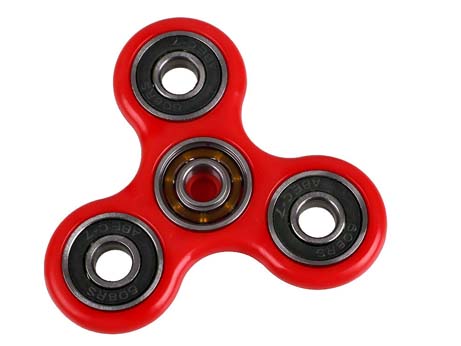
Fidget Spinners have hit India -- and kids are buying them in lakhs. But is this anything more than a passing dumb trend?
Bangalore, July 31 2017: Parents in India are waking up to ask: Fidget what? Their kids didn't need to be told. For some weeks now, Fidget spinners have been top toys on sale at Amazon and other Indian online sites. They are now available for sale on the roadside and are being hawked at traffic signals in all the metros.
What is a fidget spinner? It is a palm-sized toy with typically, three vanes like the blades of a ceiling fan in miniature. The tips are weighted and there is a ball bearing in the centre so that the user can spin it between his or her fingers. The whole thing is made of plastic and metal and there are multiple ways to spin it: between thumb and finger, balanced on one finger......
If the ball bearing is of good quality, probably made of ceramic and the tips are nicely weighted, a sharp twist will keep it spinning for a minute or more, because of the low friction. The principle is akin to that of the flywheel we study in school. It helps if the disks in the tips are also free to rotate. It adds extra torsion. This may cost a few rupees more.
You may well ask: What's the big deal? For people especially kids who feel fidgety, it is a way of keeping their fingers occupied. Elders and parents should ask themselves: didn't you, in your day, pay with a Yo-Yo or spin a top with a piece of string? Today's kids are too lazy to go outdoors so they keep clicking their ball point pens or squeezing one of those yellow sponge balls -- and now they play with a Fidget Spinner. So far nothing remarkable -- except their distractions seem to become costlier with every classroom fad. The Fidget Spinner costs around Rs 70 from roadside hawkers and Rs 130 - Rs 250 online, depending on the frills: the pricier ones come with dancing LED lights. Even this is nothing. Jumping on the craze, some toy makers sell models costing $ 500 or more in the US. To justify such extortionate prices, they have let loose a social media campaign that suggests that Fidget Spinners are some form of anxiety or stress reliever and may be beneficial for children suffering from Autism or what is known as ADHD -- Attention Deficit Hyperactivity Disorder. As of now there have been no trials or systemic studies which support any such claim.
Like all such trends fueled by social media, Fidget Spinners have become a must have gizmo for millions of young people. The only people raking in the moolah are the manufacturers who churn these things out and sell them for 50-100 times what it cost them.
They are able to do it, because the person who is credited with inventing something similar to the Fidget Spinner as we see it today was an American engineer -- Catherine Hettinger -- who applied for a patent in 1993 and won it in 1997. But no toy maker, including market leader, Hasbro saw any potential in it. So she let her patent rights lapse in 2005... and now ironically someone worked on her design to make the current product, though she gets no royalties. And Hasbro which turned her down then, is also minting money now. Ms Hettinger has come up with an improved design that she calls the Classic Fidget Spinner and is trying to crowd-source funding at Kickstarter to manufacture it -- hopefully in a few weeks.